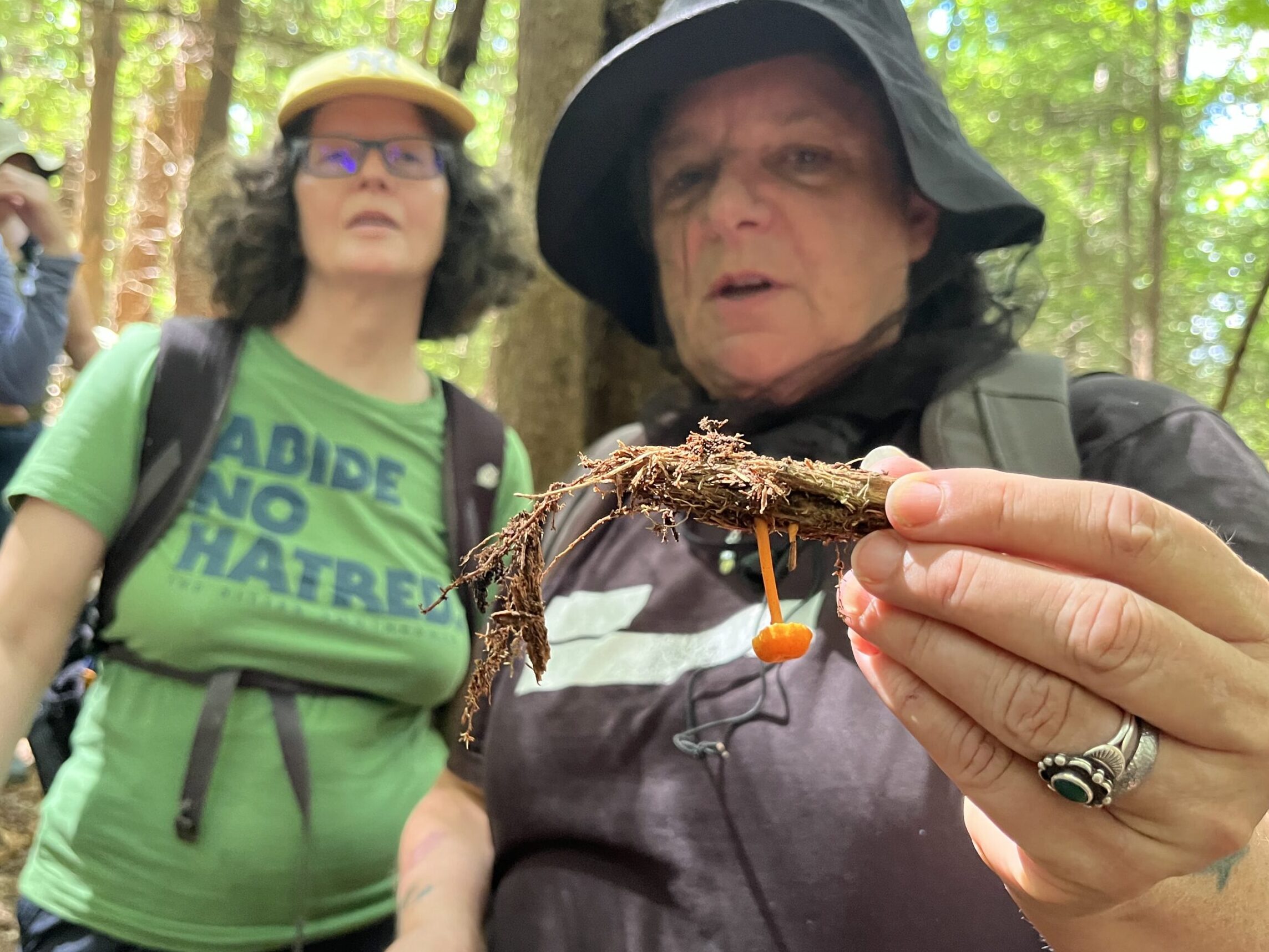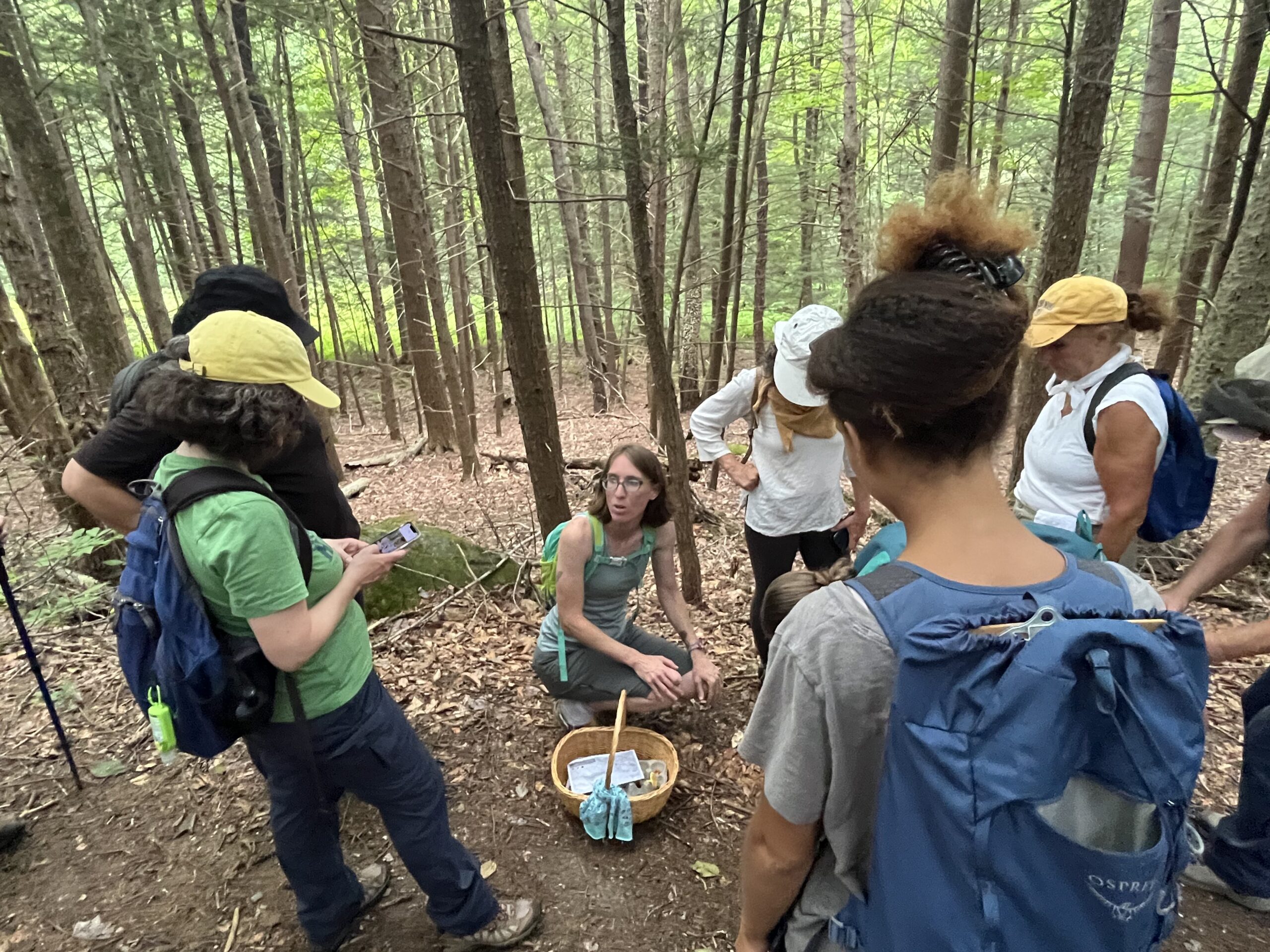By Juliette Gomes
NOTE: This article is intended to tell a story about a Hilltown mushroom walk, and is not intended as a guide to edible mushrooms. Please seek out expert advice when foraging!
This past Saturday, Hilltown Land Trust hosted an Edible Mushroom Walk with Jess Evans, the President of the Pioneer Valley Mycological Society. The educational foraging walk took place at HLT conserved trails, Conwell, in Worthington. A group of fifteen mushroomers, of all experience levels, gathered on the hot and humid morning eager to learn.

Sustainable harvest
Before heading out on the trails, Jess emphasized to the group the purpose of the walk; to learn about the edible fungi we find and the inedible mushrooms to be aware of. On the walk, we were encouraged to only pick mushrooms selectively based on their condition, how plentiful they are, and to consider only collecting a small amount for educational purposes. Sustainable harvesting practices are crucial to maintaining a good relationship with the forest and all the creatures that rely on mushrooms for food supply and mating habitat.
Although the week before was dryer than expected, there was a smattering of mushrooms along the edges of the trail. Jess explained that the mushroom season this year is about two weeks behind schedule. During our early July walk, we saw mushrooms that would normally be in bloom in June. This delay in the mushroom season is despite earlier warming temperatures and the ahead of schedule blooming of trees. The relationship between trees and mushrooms is closely linked and is important when considering the overall health of a forest.

Fungi-tree relationships
Specific mushrooms grow with specific trees, because mushrooms and trees are heterotrophic and live in co-habitation. Mushrooms rely on trees for food and create underground networks of mycelium attached to tree roots. Mushrooms in return help break down the minerals in soil that nourish trees, playing an important role in soil chemistry. Trees also communicate through mycelium networks and can send nutrients to sick trees nearby. Therefore, with increasing global temperatures and changing seasons of both trees and mushrooms, both species may be negatively impacted. With climate change, as tree die-back increases or as some tree species continue to migrate further north, some local mushrooms will be lost.

While on our hike, Jess pointed out a flowering plant, Ghost Pipe, that is often mistaken for a fungus due to its ghostly white appearance. Lacking chlorophyll, Ghost Pipes and cannot produce own food and rely on mycelium networks for nutrition. Off the Conwell trails, there were dozens of patches of Ghost Pipes halfway between trees, indicating a mycelium exchange underground and the possibility of mushrooms blooming nearby later in the season.

Meeting mushrooms
Now knowing the relationship between trees and mushrooms as well as indicators of underground mycelium networks, it was time to learn about mushroom ID features. One way of beginning to identify mushrooms includes checking the type of spore releasing structure a mushroom has. On the underside of mushroom caps, structures release spores once a mushroom is mature and ready to reproduce. There are four common structures, pores, gills, teeth, and ridges. On our walk, we saw mushrooms with pores and gills. Mushrooms with pores have a sponge like underbelly with tiny holes where spores are released from. Pore structures are tube-like and produce spores on the inner surface. Gills look like sheets or flaps of tissue radiating out from the stem and are soft and silky in texture.

Some of the edible mushrooms we came across include rooting mushroom (Hymenopellis furfuracea), platterful mushroom (Megacollybia rodmanii), and an old patch of hemlock varnish shelf (Ganoderma tsugae) growing on a downed hemlock tree. Each of these mushrooms have their own relationship with the trees and hold one of two jobs; breaking down dead wood as a decomposer or unlocking nutrients in the soil as recyclers. The hemlock varnish shelf is a great example of a decomposer, as well as a mushroom that has been subject to overharvest in recent years.

Watch out!
It is important when foraging edible mushrooms to know which mushrooms should not be harvested. Some of the deadliest mushrooms are within the Amanita genus and thus Amanitas should be avoided when foraging. Mushrooms in the genus Amanita have any or all of three characteristics; patches on the mushroom cap, ring around the stem under the cap, and either a bulge or cup shape at the base of the stem.
Circling back
Leaving the woods, we had just a taste of the wealth of Jess’s knowledge on fungi. The group gathered around Jess’s basket of specimens to admire the plentiful variety of local mushrooms, both edible and inedible, that we came across. Participants left excited for their own exploration through their backyards and other HLT trails nearby.
Top takeaways for mushroom foraging
Even on this mushroom-filled day, we found many more inedible species than tasty treats – and that’s normal, said Jess Evans. What’s more, she reminded us, mushroom hunting is an exercise in humble intentions. Slugs, bugs, squirrels, soils, and other members of the forest community rely on mushrooms to survive. If you aren’t 100% sure of a mushroom’s edibility, or if there are only a few, leave it be, she encouraged us. Otherwise, harvest a small portion and leave the rest for the forest.
To explore Conwell trails and other recreational areas for mushroom foraging, check out HLT’s trails page for more information.
